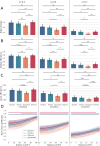Local and global effects of sedation in resting-state fMRI: a randomized, placebo-controlled comparison between etifoxine and alprazolam
- PMID: 38822128
- PMCID: PMC11399242
- DOI: 10.1038/s41386-024-01884-5
Local and global effects of sedation in resting-state fMRI: a randomized, placebo-controlled comparison between etifoxine and alprazolam
Abstract
TSPO ligands are promising alternatives to benzodiazepines in the treatment of anxiety, as they display less pronounced side effects such as sedation, cognitive impairment, tolerance development and abuse potential. In a randomized double-blind repeated-measures study we compare a benzodiazepine (alprazolam) to a TSPO ligand (etifoxine) by assessing side effects and acquiring resting-state fMRI data from 34 healthy participants after 5 days of taking alprazolam, etifoxine or a placebo. To study the effects of the pharmacological interventions in fMRI in detail and across different scales, we combine in our study complementary analysis strategies related to whole-brain functional network connectivity, local connectivity analysis expressed in regional homogeneity, fluctuations in low-frequency BOLD amplitudes and coherency of independent resting-state networks. Participants reported considerable adverse effects such as fatigue, sleepiness and concentration impairments, related to the administration of alprazolam compared to placebo. In resting-state fMRI we found a significant decrease in functional connection density, network efficiency and a decrease in the networks rich-club coefficient related to alprazolam. While observing a general decrease in regional homogeneity in high-level brain networks in the alprazolam condition, we simultaneously could detect an increase in regional homogeneity and resting-state network coherence in low-level sensory regions. Further we found a general increase in the low-frequency compartment of the BOLD signal. In the etifoxine condition, participants did not report any significant side effects compared to the placebo, and we did not observe any corresponding modulations in our fMRI metrics. Our results are consistent with the idea that sedation globally disconnects low-level functional networks, but simultaneously increases their within-connectivity. Further, our results point towards the potential of TSPO ligands in the treatment of anxiety and depression.
© 2024. The Author(s).
Conflict of interest statement
SW, MR, LMB, PS, VW, CN, and JS declare no conflicts of interest. RR has served as a consultant for Biogen and SAGA Therapeutics.
Figures





Similar articles
-
Dissociation of endocrine responses to the Trier Social Stress Test in Virtual Reality (VR-TSST) by the benzodiazepine alprazolam and the translocator protein 18 kDa (TSPO) ligand etifoxine.Psychoneuroendocrinology. 2021 Feb;124:105100. doi: 10.1016/j.psyneuen.2020.105100. Epub 2020 Dec 5. Psychoneuroendocrinology. 2021. PMID: 33338971 Clinical Trial.
-
Differential effects of the translocator protein 18 kDa (TSPO) ligand etifoxine and the benzodiazepine alprazolam on startle response to predictable threat in a NPU-threat task after acute and short-term treatment.Psychopharmacology (Berl). 2022 Jul;239(7):2233-2244. doi: 10.1007/s00213-022-06111-x. Epub 2022 Mar 12. Psychopharmacology (Berl). 2022. PMID: 35278124 Free PMC article.
-
Etifoxine versus alprazolam for the treatment of adjustment disorder with anxiety: a randomized controlled trial.Adv Ther. 2015 Jan;32(1):57-68. doi: 10.1007/s12325-015-0176-6. Epub 2015 Jan 27. Adv Ther. 2015. PMID: 25620535 Free PMC article. Clinical Trial.
-
GABAergic Effects of Etifoxine and Alprazolam Assessed by Double Pulse TMS.Pharmacopsychiatry. 2023 Jul;56(4):154-161. doi: 10.1055/a-2078-4823. Epub 2023 May 23. Pharmacopsychiatry. 2023. PMID: 37220781 Clinical Trial.
-
Melatonin for preoperative and postoperative anxiety in adults.Cochrane Database Syst Rev. 2020 Dec 8;12(12):CD009861. doi: 10.1002/14651858.CD009861.pub3. Cochrane Database Syst Rev. 2020. PMID: 33319916 Free PMC article.
Cited by
-
The clinical relevance of healthy neurodevelopmental connectivity in childhood and adolescence: a meta-analysis of resting-state fMRI.Front Neurosci. 2025 Jun 26;19:1576932. doi: 10.3389/fnins.2025.1576932. eCollection 2025. Front Neurosci. 2025. PMID: 40641623 Free PMC article.
-
Diazepam modulates hippocampal CA1 functional connectivity in people at clinical high-risk for psychosis.Psychol Med. 2025 Aug 8;55:e230. doi: 10.1017/S0033291725101268. Psychol Med. 2025. PMID: 40776396 Free PMC article. Clinical Trial.
-
Effect of a single dose of lorazepam on resting state functional connectivity in healthy adults.Brain Imaging Behav. 2025 Jul 12. doi: 10.1007/s11682-025-01043-4. Online ahead of print. Brain Imaging Behav. 2025. PMID: 40646404
-
Pharmacological manipulation of neurotransmitter activity induces disparate effects on cerebral blood flow and resting-state fluctuations.Imaging Neurosci (Camb). 2024 Nov 20;2:imag-2-00370. doi: 10.1162/imag_a_00370. eCollection 2024. Imaging Neurosci (Camb). 2024. PMID: 40800493 Free PMC article.
References
-
- Sadock J, Sadock A, Ruiz P. Kaplan and Sadock’s comprehensive textbook of psychiatry. In: Kaplan and Sadocks comprehensive textbook of psychiatry. Wolters Kluwer; 2017. https://books.google.de/books?id=gsDljwEACAAJ.
Publication types
MeSH terms
Substances
Grants and funding
LinkOut - more resources
Full Text Sources
Medical

